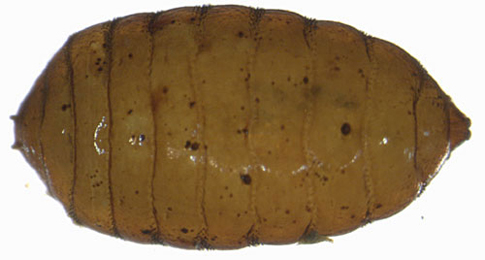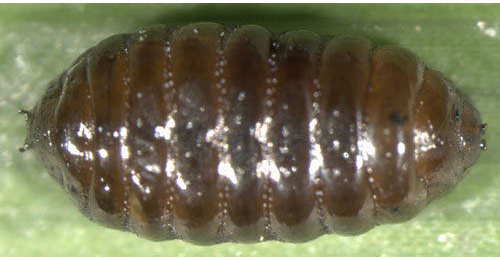 |
| |
(Coleoptera, Diptera, Hymenoptera and Lepidoptera)
by
Brian Pitkin, Willem Ellis, Colin Plant and Rob Edmunds
|
|
|
Agromyza
pseudoreptans Nowakowski, 1964
[Diptera:
Agromyzidae] |
Agromyza
urticae Nowakowski, 1964. Dt. ent. Z. [2] 11:
192. [Preoccupied by Agromyza urticae Watt, 1924: 685]
Agromyza pseudoreptans Nowakowski, 1967. Polskie Pismo
ent. 37: 658
Agromyza pseudoreptans Nowakowski, 1967; Spencer, 1972b. Handbk
ident. Br. Ins. 10(5g): 34 (figs 92-3), 35,
121
Agromyza pseudoreptans Nowakowski, 1967; Spencer, 1976.
Fauna ent. Scand. 5(1): 136, figs 241-3.
Agromyza pseudoreptans Nowakowski, 1967; Spencer, 1990.
Host specialization in the world Agromyzidae (Diptera)
: 54, 57, 58 (fig. 217), 93, 198, 299.
|
|
Leaf-miner: Larva
forming an irregular elongate linear blotch mine, normally adjoining
margin of leaf (Spencer, 1976:
137).
Forms a long blotch mine, which is usually adjacent to the edge of the leaf, which turns black (British
leafminers).
Full
depth corridor, mostly beginning at the leaf margin, and never starting
with a closely set, intestine-like, number of curves. Further on
the corridor considerably widens, mostly keeping close to the leaf
margin. Often several larvae in a mine. Frass in lumps or short
rods, never in long threads. Pupation outside the mine (Bladmineerders van Europa).
Larva: The larvae of flies are leg-less maggots without a head capsule (see examples). They never have thoracic or abdominal legs. They do not have chewing mouthparts, although they do have a characteristic cephalo-pharyngeal skeleton (see examples), usually visible internally through the body wall.
The larva is described by Dempewolf (2001: 48). Posterior spiracles each with 3 bulbs, surrounded
by four groups of hairs (Spencer, 1972b: 35, fig. 93).
 |
| The puparia of flies are formed within the hardened last larval skin or puparium and as a result sheaths enclosing head appendages, wings and legs are not visible externally (see examples).
The puparium is illustrated in Bladmineerders van Europa. It varies in colour from black to almost yellow;
posterior spiracular processes separated by their own diameter,
each with 3 bulbs (Spencer, 1976:
132).
Hosts in Great Britain and Ireland:
Hosts
elsewhere:
Time
of year - mines: August-September.
Time
of year - adults: April-August the following year.
Distribution
in Great Britain and Ireland: Widespread in Britain (Spencer, 1972b: 38) including Huntingdonshire and Oxford (Robbins,
1991: 141), East Perth (Ardblair Moss), Haddington (Luffness)
(Bland, 1994c: 81) and Cambridgeshire,
East Cornwall, East Suffolk (NBN
Atlas).
Also
recorded in the Republic of Ireland (Fauna Europaea). Distribution elsewhere: Widespread in continental Europe including Denmark, Finland,
Germany, Hungary, Poland (Spencer,
1976: 132), The Netherlands (Bladmineerders van Europa), Belgium (Scheirs
and de Bruyn, 1992), Czech Republic, Estonia, Hungary, Lithuania,
Poland and Slovakia (Fauna Europaea).
Also
recorded in Japan (Spencer, 1990).
NBN Atlas links to known host species:
British and Irish Parasitoids in Britain and elsewhere:
|
|
| |


